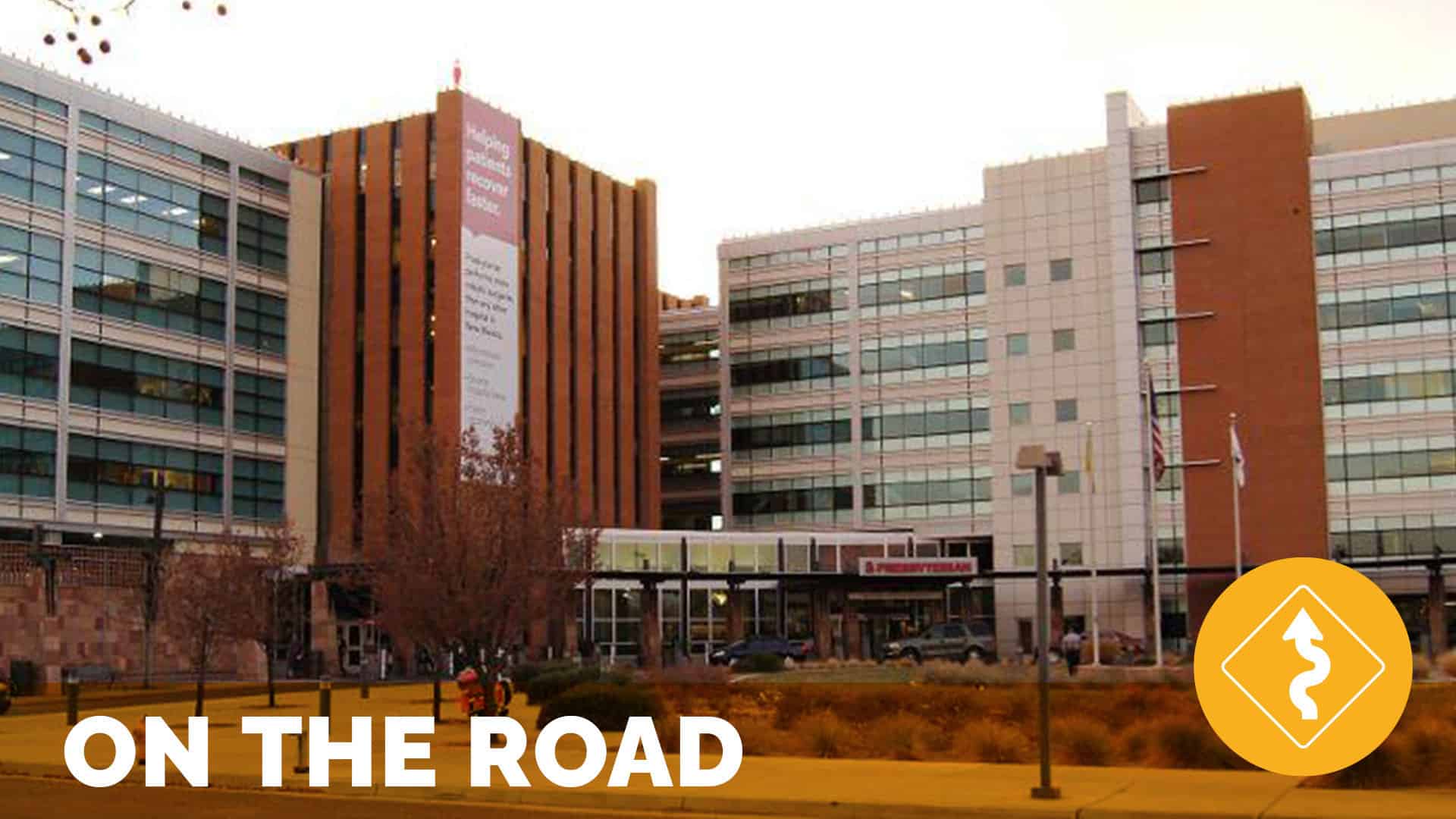Creating the Foundation for an Exceptional Patient Experience

On the Road with Presbyterian Healthcare Services – February 2014
by Jason A. Wolf
My most recent On the Road took me to the rainbow of earthen hues painting Albuquerque, New Mexico and Presbyterian Healthcare Services. My visit was an integrated exploration of work in progress, sustained practices and the opportunity to share insights and engage in discussion with frontline staff, clinical leaders and administration. The timing of this visit was around the Exceptional Patient Experience (EPE) Quarterly Celebration, about which I will share more below, and afforded me the unique chance to experience an effort to guide a strategic patient experience effort in a way I have yet to see.
Setting the Stage for Patient Experience
Presbyterian made a conscious decision as a system to address the issue of experience in 2005 and began a journey of purposeful work, process evaluation and people alignment. Over the last eight years the efforts have flourished, engaging countless leaders and driving significant cultural and organizational changes. Of importance for Presbyterian was engaging in their work as an integrated system including hospitals, outpatient settings, ambulance systems and even a system-owned health plan. This was a massive undertaking requiring coordination and focused action.
The effort took time to get footing and started with tangible and manageable efforts. Ultimately, according to Jane Gully, MN, RN, Exceptional Patient/Member Experience Program Manager, the overall purpose of the work “has been to provide a framework and system that allows our Presbyterian Integrated Care team to create an exceptional experience for our customers (patients and members), families, and each other.” The EPE/EME work was based on the First Touch® Building Connections program and that initial training served to start the process rolling in 2006 with nursing staff at the system’s flagship hospital.
The model was built on a comprehensive picture of all the touch points that impact the experience of patients and families. From general communication and process considerations, to support and clinical engagement processes to bring a personal touch to the work, Presbyterian is hard at work and committed to providing the best in quality, safety and service for all who experience the system. At the core of the EPE/EME work is the engagement of champions/leaders from across the system. I had the privilege to see them in action.
Exceptional Patient Experience in Action
Central to the EPE/EME process is the engagement of leaders at all levels. In fact in the last six years of the effort, over 700 champions have been identified from various levels of leadership. The effort is supported by a program manager, two dedicated experience coaches, an external consultant, Lolma Olson, and is championed at the executive level by Kathy Davis, Senior Vice President, Chief Nursing Officer, and Chief of Quality Services. The purpose of identifying these 700 frontline leadership champions was to ensure the people closest to the patients and customers were serving as well informed and purposeful leaders. Bringing together the champions on a quarterly basis allows for the reinforcement of commitment to follow a “one Presbyterian” approach and help individuals realize at every level and in each role they have a critical part to play in the delivery of experience.
The quarterly event serves as a means to inform, educate, share and reenergize efforts at experience improvement. It starts out with welcome and introductions, including an executive welcome. Dr. David Arredondo, MD, Executive Medical Director, Presbyterian Medical Group opened the session by sharing his own experience story, which set the stage for a powerful session of sharing the impact of the work people were seeing. The meeting also included some expert commentary, which I was honored to share and then covered the key learning items and focus for the quarter. Most importantly the event was focused on celebrating and reinforcing the efforts of these leaders.
The significance of the event was that it included leaders from across functional areas from all aspects of the care continuum and brought them together to share the power of their stories and commitment to a singular Presbyterian experience. This reinforced an important component underlying the entire experience effort; it is the relationships among and engagement of the people at Presbyterian that drives the ability to deliver an exceptional experience. This idea of leadership at all levels was exemplified in the stories and experience I had as I rounded at Presbyterian Hospital.
Views from the Front
My views from the front took me to three areas of the hospital, and noted as just a taste of all the work happening in the system. I had the chance to experience offstage in dietary, a Surgical Specialty Care unit and the Emergency Department. This was my chance to see the exceptional patient experience in action. These three distinct places allowed me to explore further elements critical to exceptional experience – the power of expectation setting and responsiveness, the importance of personal accountability and the central need of understanding patient perspectives. These three brief cases help illustrate some of the efforts taking place around the broader EPE effort.
Dietary – A lesson in responsiveness with a smile
I had the chance to spend time with the dietary team and their leader, Terri Archibeque, Director of Food Services. The story they shared was one in which dietary has transformed into a leader in the exceptional experience. With a combination of refocused efforts, lean process redesign and the alignment of the right people the dietary team turns hundreds of meals daily, made to order and delivered with a smile to a patient’s room. I have seen many organizations offer “room service” as an amenity in their service efforts, but have not experienced one such as this, that was organized and reinforced with data and process review and supported by such a committed team.
The walls in the back of the house remind the team that the work is about “Every patient, every tray, every time,” and the team is committed to this process. The flow of their work was seamless from order taking, to tray assembly, to distribution for delivery, to the delivery itself; the team each understood the value of their role. This was no better exemplified that in the story that was shared about the birthday club. The team began to track the birthdays of people in the facility and then found a way to help them celebrate. One of their first encounters was with an elderly woman. As they entered the room with a cake and a small team of people, they began to sing and she began to cry. As the team finished the song they asked her what was the matter and she simply responded “nothing at all,” but rather told them what a difference they made for her as she has not had anyone sing happy birthday to her for years. This little touch inspired by individuals who know the value of a positive interaction made all the difference.
Emergency Department – Making improvement through managing personal accountability
The next stop on my rounding took me to the Emergency Department (ED). As an urban hospital, the ED is a high volume, high acuity operation with 51 beds being managed with the precision of flights at a major airport. For an environment that can be at best chaotic, the sense of calm and focus on the patient was unmistakable. In speaking with Kent Roman, Manager of Presbyterian Hospital Emergency Department, he shared the critical perspective that for their efforts in the ED, the power was in linking employee satisfaction to experience. He mentioned at the foundation was the process of hiring for the right fit, noting that some of the best hires didn’t always come from direct previous clinical experience, but from high volume, high-pressure experience roles including waitresses, baristas and others. The critical nature of identifying people that can meet the urgent needs patients have in the ED, while ensuring their safety and the best outcomes possible is a tight balance to walk.
To manage the process, the ED team has worked to reinforce the behaviors and actions of both the nursing and physician staffs. A strong partnership has been established, specifically with the employed physicians to provide a formal coaching program focused on pace, quality and exceptional experience. The outcomes have been extremely successful in helping these doctors understand their crucial role on the care team and recognizing their impact on the experience for patients and families.
This effort also includes nurses and focuses on the critical issue I know many organizations continue to struggle with, namely accountability. The team in the Presbyterian ED has worked out a way to pull individual score reports from their measurement vendor data sets. The ability to provide the data to an individual, be it good or bad, provides an objective basis for action – both around improvement and recognition. This ability to help people, also understanding the impact of their actions on actual outcomes and getting a sense of the real consequences, has provided a strong accountability process for the team. The combination of right people and right encouragement and support has led to significant improvements for the ED.
Surgical Specialty Care – Taking the step to define efforts and understand patient perspective
Another stop on my visit took me to the Surgical Specialty Care unit and time with Georgia Froke, Nurse Manager for the unit. Georgia shared the story of tackling the pain management issues faced in a recovery unit such as hers and the challenges faced in keeping pain management scores up overall. To address the issue, the team realized the need to focus on what good pain management was. This was a shift from a mindset of simple delivery protocols, to one of both responsiveness and realistic education about pain overall. In taking the time to have honest conversations with patients about pain and what can be done to relieve it, the nurses on the unit were able to have much more realistic pain targets, and understand and manage expectations fully. By working with patients up front as partners in the pain experience, the team was able to drive their scores up significantly.
More so, this shift in the process quickly made it clear who was not taking the time to engage with their patients around pain in this way. The reality led to teachable moments, opportunities to hold people accountable for their actions and reinforced the importance of experience overall. While a simple sounding solution, it requires focused efforts and represents a profound shift from the way I have seen many tackle the pain issue. By taking what may feel like more time up front, you save more time in the end and provide a better experience and outcome.
Lessons and Considerations
While no On the Road summary can provide a view of all I experienced or tell the totality of what an organization is working to achieve, I do want to note the new expanding strategic effort Presbyterian is taking on in launching a cross functional and system-wide Customer Experience Advisory Council to guide system-wide work. Facilitated by Donna Agnew, RN, MBA, Administrative Director Process Excellence and Patient Experience, this group is hard at work to reenergize and refocus the customer experience across the enterprise. By framing a central and standard definition for experience and identifying, analyzing and implementing practices based on positive and proven national trends, this council will work across all aspects of the experience effort at Presbyterian to lead them into the future.
The common themes I saw emerging from my time at Presbyterian were clear. They included:
- A focus on having the right people on board. Not only are right people central to the best delivery possible, but there is a recognition that satisfied people lead to positive experiences for patients.
- A commitment to accountability. Across the settings I visited there were process checks, leadership efforts and other mechanisms to ensure people were not only aware of their expected actions and behaviors, but were held accountable to them consistently. The operative word being consistent, as accountability only works if it is managed as a two-way relationship in which feedback and responsive actions must all take place.
- Clarity in direction. The organization has a clearly defined purpose, and more significantly each individual has a personal plan that aligns to the organizational objectives. This alignment of forces in one direction, as exemplified with the large and growing number of EPE Champions, can only help support and even strengthen experience efforts and improvement overall.
In asking Jane Gulley what she saw as the contributions of the EPE effort so far, she was focused and unwavering in her reply:
- We have been able to expand efforts of excellence around our patients’ experiences.
- We have reconnected staff with their sense of purpose as to why they went into healthcare.
- We have unified the organization around the goal of continually seeking to improve the patient experience for all our customers.
- We have reconnected to our 106 year-old legacy of caring for patients, members, families and each other.
At the end of the day, that may be the essence of so much of what we attempt to do in patient experience improvement. Ensuring excellence, reigniting purpose, aligning direction and reconnecting to our roots. There is a great and lasting strength in the ability to do this in any organization. Presbyterian exemplified how they did it in the name of the exceptional patient experience overall.
Thanks to the entire team at Presbyterian for their warm welcome, powerful conversations and insights and intent focus on the patient experience. From the ability to share ideas and observe comes great learning and both the generosity and commitment of the team exemplify an organization working to drive strong outcomes overall. Admittedly, as many organizations do, they offered the struggles they still face in scores, but they celebrate the great efforts they have in place and you can see the positive impact they are having.
Related content
-
 Staff & Provider Engagement
Staff & Provider EngagementCAVS Informational Webinar: Your Guide to CAVS Credentialing Process (November 2025)
12pm ET / 11am CT / 10am MT / 9am PT (Complimentary) – Join us for an informational webinar hosted by The Beryl Institute Credentialing team. In this session, we will walk you through everything you need to know about the CAVS (Certified Administrator of Volunteer Services) credential, intended for individuals working in healthcare volunteer
Learn more -
 Culture & Leadership
Culture & LeadershipTo Care is Human – LIVE! A Conversation with Dr. Owais Durrani
Recorded live at ELEVATE PX 2025, this episode of To Care is Human features Jason Wolf and Dr. Owais Durrani. Listen in as they discuss his journey in healthcare, the role of AI, and the importance of equitable care. Key takeaways included the need for ethical AI use, the critical role of communication in hospitals,
Learn more -
 Culture & Leadership | Infrastructure & Governance
Culture & Leadership | Infrastructure & GovernanceDeveloping Multidisciplinary Committees for Patient Experience Effectiveness
This webinar explores how to move beyond recognizing the value of patient experience to embedding patient- and family-centered care into organizational culture. Learn how Patient Experience Committees, including a successful Cleanliness Committee, have driven improvements in HCAHPS scores, engagement, and collaboration. Discover strategies for structuring a Patient Experience Steering Committee with multidisciplinary subcommittees aligned to
Learn more
